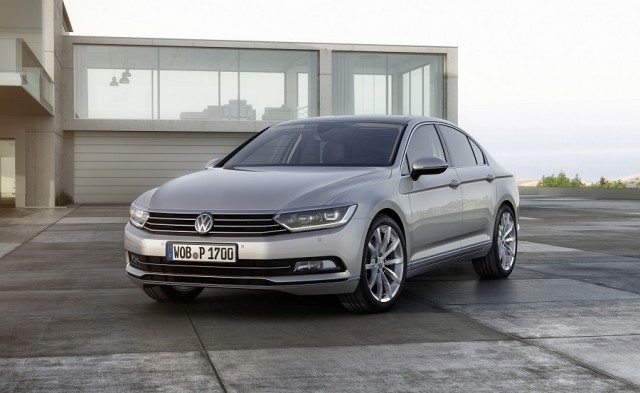Volkswagen has unveiled the eighth generation of its Passat, which is due to arrive in Ireland in 2015. Built on the modular MQB platform it is sleeker and sportier looking than before but offers more interior space. With over 1.1 million Passats sold last year alone it's no surprise that the new model is more an evolution than revolution, but it will introduce many new technologies as well as a further evolution of its current design language.
Exterior
It is clear that the current Volkswagen CC model has had an influence on the exterior form of the new Passat, but there are also touches of the Mk7 Golf. The grille and headlights, which appear to blend into each other giving a broad, somewhat sleek look, have certainly been borrowed from the Passat's sexier cousin. The line along the top of the grille flows around the bonnet's leading edge and back along the flanks of the car giving it a clearly defined character line that continues right the way around to the rear of the car. When viewed from behind the Passat looks wider and sportier than before, with trapezoidal rear lights that follow the Golf's lead and twin exhaust outlets built into the lower bumper.
The CC also contributes its lower roofline with Volkswagen designers chopping 14mm from the new Passat's height, giving it a sleeker appearance. This look is helped by the stretched profile of the car with 79mm added to the wheelbase, making for better legroom inside. On top of that there are shorter overhangs front and rear. Despite the increased space between the wheels the new car is actually 2mm shorter than the one it will replace.
Interior
On the inside, designers placed a higher emphasis on delivering a driver-orientated design with particular attention being paid to the dashboard and centre console. Running across the face of the dashboard is a simple and well executed design that incorporates the car's ventilation system and traditional analogue clock at its centre. Just below this - and running into the door panels and back through the cabin - are ambient light strip that can be switched into different colours depending on the driver's mood.
Also adjustable depending on preference is the optional 12.3-inch high definition display, which can be ordered in place of the standard instruments. It is the same unit as will be in the new Audi TT with just the software changing between cars. There will also be an optional head-up display, which will relay the most important information into the driver's line of sight.
Mechanicals
Buyers of the new Passat will have the usual choice of petrol and diesel engines. From launch, the Passat will be offered with a 2.0-litre 150hp diesel engine with emissions of 108g/km and consuming 4.1 litres/100km - an improvement of 0.5 litres/100km over previous versions of the engine. This should be the most popular choice amongst Irish buyers, but they will also have the option of a more powerful bi-turbo diesel engine that will come later with an output of 240hp and 500Nm and will run Volkswagen's 4Motion all-wheel drive system. Petrol engines will start with a 125hp turbocharged four-cylinder unit, but the 150hp version of the same engine could be a more popular choice for what will ultimately still be a minority of buyers.
In addition to the standard range of petrol and diesel engines, Volkswagen will also offer a plug-in hybrid model that will give the new Passat the ability to drive for limited periods of up to 50 kilometres using only electric power. It is a very similar system to what will be rolled out in the forthcoming Golf GTE with a total system output of 211hp while returning a quoted 1.5 litres/100km and emitting just 35g/km. It is unclear at this stage as to whether Volkswagen will bring this particular model to the Irish market, but with the planned introduction of the Golf GTE in early 2015 it is likely that the Passat plug-in hybrid will be offered.
Anything else?
A multitude of advanced technological systems will be on offer in the new Passat including an Emergency Assist system that has the ability to autonomously stop the car in the event of an the driver becoming incapacitated. When sensors detect that the driver is not exhibiting any steering, braking or acceleration the system attempts to alert the driver and should there be no response will then perform an emergency stop.

